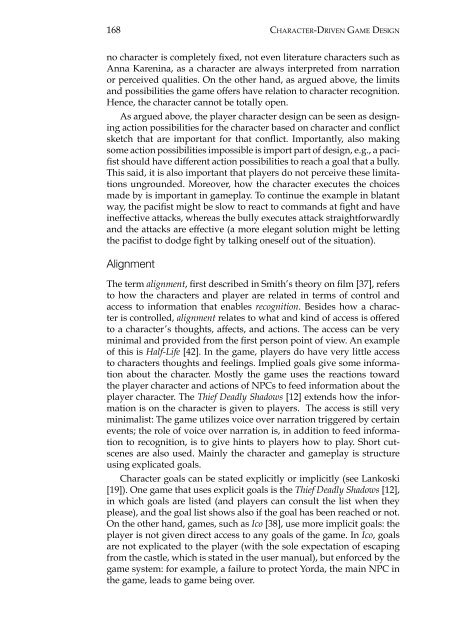Character Driven Game Design
Character Driven Game Design
Character Driven Game Design
Create successful ePaper yourself
Turn your PDF publications into a flip-book with our unique Google optimized e-Paper software.
168<br />
<strong>Character</strong>-<strong>Driven</strong> <strong>Game</strong> <strong>Design</strong><br />
no character is completely fixed, not even literature characters such as<br />
Anna Karenina, as a character are always interpreted from narration<br />
or perceived qualities. On the other hand, as argued above, the limits<br />
and possibilities the game offers have relation to character recognition.<br />
Hence, the character cannot be totally open.<br />
As argued above, the player character design can be seen as designing<br />
action possibilities for the character based on character and conflict<br />
sketch that are important for that conflict. Importantly, also making<br />
some action possibilities impossible is import part of design, e.g., a pacifist<br />
should have different action possibilities to reach a goal that a bully.<br />
This said, it is also important that players do not perceive these limitations<br />
ungrounded. Moreover, how the character executes the choices<br />
made by is important in gameplay. To continue the example in blatant<br />
way, the pacifist might be slow to react to commands at fight and have<br />
ineffective attacks, whereas the bully executes attack straightforwardly<br />
and the attacks are effective (a more elegant solution might be letting<br />
the pacifist to dodge fight by talking oneself out of the situation).<br />
Alignment<br />
The term alignment, first described in Smith’s theory on film [37], refers<br />
to how the characters and player are related in terms of control and<br />
access to information that enables recognition. Besides how a character<br />
is controlled, alignment relates to what and kind of access is offered<br />
to a character’s thoughts, affects, and actions. The access can be very<br />
minimal and provided from the first person point of view. An example<br />
of this is Half-Life [42]. In the game, players do have very little access<br />
to characters thoughts and feelings. Implied goals give some information<br />
about the character. Mostly the game uses the reactions toward<br />
the player character and actions of NPCs to feed information about the<br />
player character. The Thief Deadly Shadows [12] extends how the information<br />
is on the character is given to players. The access is still very<br />
minimalist: The game utilizes voice over narration triggered by certain<br />
events; the role of voice over narration is, in addition to feed information<br />
to recognition, is to give hints to players how to play. Short cutscenes<br />
are also used. Mainly the character and gameplay is structure<br />
using explicated goals.<br />
<strong>Character</strong> goals can be stated explicitly or implicitly (see Lankoski<br />
[19]). One game that uses explicit goals is the Thief Deadly Shadows [12],<br />
in which goals are listed (and players can consult the list when they<br />
please), and the goal list shows also if the goal has been reached or not.<br />
On the other hand, games, such as Ico [38], use more implicit goals: the<br />
player is not given direct access to any goals of the game. In Ico, goals<br />
are not explicated to the player (with the sole expectation of escaping<br />
from the castle, which is stated in the user manual), but enforced by the<br />
game system: for example, a failure to protect Yorda, the main NPC in<br />
the game, leads to game being over.
















